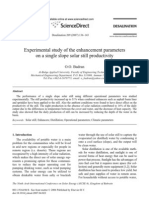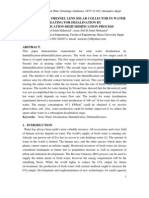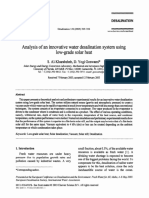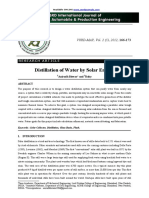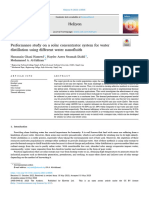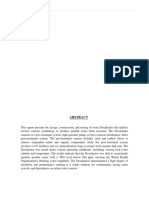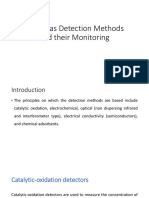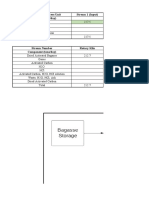Multi-Effect Passive Desalination System, An Experimental Approach
Multi-Effect Passive Desalination System, An Experimental Approach
Uploaded by
AliMchirguiCopyright:
Available Formats
Multi-Effect Passive Desalination System, An Experimental Approach
Multi-Effect Passive Desalination System, An Experimental Approach
Uploaded by
AliMchirguiOriginal Title
Copyright
Available Formats
Share this document
Did you find this document useful?
Is this content inappropriate?
Copyright:
Available Formats
Multi-Effect Passive Desalination System, An Experimental Approach
Multi-Effect Passive Desalination System, An Experimental Approach
Uploaded by
AliMchirguiCopyright:
Available Formats
World Applied Sciences Journal 10(10): 1264-1271, 2010
ISSN 1818-4952
IDOSI Publications, 2010
Multi-Effect Passive Desalination System, An Experimental Approach
1
Rasool Kalbasi and 2Mehdi Nasr Esfahani
Islamic Azad University, Najafabad Branch
2
Islamic Azad University, Lenjan Branch
Abstract: Solar stills are very simple to construct and to operate but their efficiency and productivity are fairly
low. To increase the yield from stills different methods were adopted. In this paper, an experimental
investigation on single and double effect desalination systems are reported and effects of some parameters
such as water depth, input radiation intensity and salinity on the productivity of the system is discussed.
Increase in water depth in the basins, decrease in the radiation intensity and increase in the salinity reduces
the system production rate. Using a passive double effect desalination system increases the yield of the system
considerably.
Key words: Desalination
Multi-effect
Concentration
INTRODUCTION
More than two-third of the earths surface is covered
with water. Most of the available water is either present as
seawater or icebergs in the Polar Regions. More than 97%
of the earths water is salty; rest around 2.6% is fresh
water. Less than 1% fresh water is within human reach [1].
The shortage of drinkable water in many areas of the
world is an old problem. In addition, these areas also have
a limited supply of conventional energy, although some
have a great potential in solar energy. Nowadays, various
methods of desalination have been developed including
reverse osmosis (RO), multi-stage flash (MSF), multieffect distillation (MEF) and electro dialysis. These
desalination units require fossil/electric energy sources.
A small-scale, cost-effective conventional solution such
as reverse osmosis (RO) or electro dialysis (ED) is not
presently available to meet this need. This necessitates
designing desalination processes that use renewable
energy such as solar energy in the least capital-intensive
manner.
Desalination from oceans is the attractive solution for
this fresh water shortage problem. Solar distillation is a
process where solar energy is used to distill fresh water
from saline/ brackish water. There are several methods
of using solar energy to distill water from a salt solution.
One of the simplest is used in the conventional solar stills
for desalination of brackish water. In this method, the
suns rays passes though the glass roof (condensing
Solar still
Passive
Radiation
surface) and are absorbed by blackened bottom of the
basin. As the water is heated, its vapor pressure is
increased. The produced vapor goes up due to difference
temperature between water and condensation surface.
The resultant vapor is condensed on the condensation
surface and runs down into the reservoir.
Desalination is generally classified into passive and
active distillation systems. The work on passive solar
distillation has been reviewed by Malik et al. [2]. Later on
further review was carried out by Tiwari [3], which also
includes the work on active solar distillation.
Since the early 1960s, numerous solar stills single/
double or multiple passive / active have been built and
investigated by engineers and scientists. Their yields
were in the range of 2-4 lit/m2-day according to the type of
still and the location/season in which it was operated [4].
Solar stills are very simple to construct and to operate but
their efficiency and productivity are fairly low. To increase
the yield from stills different methods were adopted by
various researchers such as:
Reducing bottom loss coefficient, reducing water
depth in basin/multi-wick solar still, using reflector, using
internal and external condensers, using back wall with
cotton cloth, use of dye ,use of charcoal, use of energy
storage element , use of sponge cubes, multi-wick solar
still, condensing cover cooling, inclined solar still and
increasing evaporative area [1].
In conventional solar still, the latent heat of
vaporization is transferred to ambient. By reusing latent
Corresponding Author: Rasool Kalbasi, Department of Mechanical Engineering, Isfahan University of Technology, Iran.
Tel: +98-9133086563, Fax: +98-311-2342924, E-mail: r.kalbasi@me.iut.ac.ir.
1264
World Appl. Sci. J., 10(10): 1264-1271, 2010
heat of vaporization the yield will be increased. This can
be achieved either by flowing water over the condensing
cover or by placing another basin of water over the
condensing cover of the first basin, as done in the case of
the double-basin solar still. However, in a double-basin
solar still, the incoming solar flux available at the
blackened surface is reduced in comparison to a singlebasin solar still.
In conventional solar still, the same surface
(transparent cover) is used for input as well as output of
energy. On the other hand by passing the suns rays
though the glass roof, its temperature increased. This
subject has a negative effect on evaporation coefficient.
This problem has overcome by using another surface for
energy input, so the transparent cover acts only as a
condensation surface. Due to separation of condensing
cover (cold surface) and receiving of solar energy surface,
the temperature difference between condensing cover and
water surface is increased for higher yield.
Three models have been suggested to separate the
input and output surfaces as shown in
Both of inverted absorber and multi effect solar still,
reuse the latent heat of vaporization, so the daily output
in these methods are higher than external condenser
method.
The work on multi effect solar still has been done by
various researchers. Fernandez and Chargoy [8] built a
solar still based on the principal of a stacked tray array for
tandem distillation and heat recovery. A simple
mathematical model was evolved and calibrated with field
data to make it fit adequately experimental results
gathered along 14 months of continues. In the
experimental set-up used by them, the water in the lowest
basin was preheated by the use of a flat plate liquid
collector. They studied the performance of the solar still
up to seven stages and observed that the yield increases
with the number of stages. No optimization of the number
of stages was reported.
Adhikari [9] prepared a computer simulation model for
studying the steady state performance of a multi-stage
staked tray solar still. Effect of heat input and variation of
daily distillate yield as a function of the number of stages
for a typical set of parameters has been studied. The
proposed model has been validated by the results of
simulated experiments on a three-stage stacked tray solar
still. The results showed that the daily distillate yield
increases with a corresponding increase in the number of
stages of the distillation system.
Schwarzer [10] studied the numerical simulation and
the experimental laboratory water tests for a thermal
desalination unit with a heat recovery system. The system
components were a solar collector and a desalination
tower, although the system could be operated with other
energy sources. Because of the heat recovery process,
the proposed unit can reach a higher thermal performance
than the conventional still-type solar distiller. The
numerical results calculated using ambient data show that
the production rate can reach 25 L/m2.d which is by a
factor of five times greater than the rate of a basin-type
solar desalination unit. The proposed solar still had two
basic system components; a flat plate collector and a
desalination tower. A copper piping system connects
these two components. As solar radiation hits the
collector, the working fluid (an oil) is heated up and
moves, by natural convection, to the highest point of the
system where a heat exchanger is located.
Yousif and Ismail [6] worked on a new multistage
evacuated solar desalination system. The new concept
uses a vacuum to enhance the evaporation and to reduce
the amount of the non condensable gases inside the solar
still. The multi-stage evacuated solar still consists of three
stages, which were perfectly insulated from the outside
environment. The three stages were mounted on top of
each other and perfect sealing is maintained between the
stages to prevent any vapor loss through the contact
surfaces between the stages. Heat is supplied to the
system from the solar collector through the lower stage by
means of a heat exchanger. A solar operated vacuum
pump is used to evacuate the three stages from the non
condensable gases. A model for the system was
developed and used to optimize the system design. The
new model was subjected to a Finite Element Analysis
(FEA) structural analysis using MSC/NASTRAN FEA
software. A Computational Fluid Dynamics (CFD)
simulation of the evaporation and condensation process
inside one stage of the new solar still was conducted
using FLUENT software. The system prototype was
fabricated and tested at the actual outdoor ambient
conditions for a period of 3 months. Comparing the
productivity of the solar still at the atmospheric pressure
working conditions and the productivity at different
vacuum pressure conditions showed that the productivity
at the latter increased by about 20% when the pressure
reduced to 0.7 bar and increased by about 45% when the
pressure reduced to 0.5 bar
Tiwari [11] presented a report on the annual as well as
seasonal performance analysis for six different water
depths in a single slope passive solar still. The lower
depth has found giving the highest annual yield.
Increasing the water depth decreases the yield of
the still up to depths of about 0.1 m but at greater
depths than this the yield becomes almost constant.
1265
World Appl. Sci. J., 10(10): 1264-1271, 2010
Inverted solar still [5]
Fig. 1:
Multi effect solar still [6]
Conventional solar still with external condenser [7]
The effect of various parameters like solar fraction and
hourly values of solar azimuth and altitude angles, air
velocities, basin absorptivity have been studied and
compared for the different water depths in still.
In this paper, both of technique; increasing difference
(separating of input and output energy) and heat
recovery (reuse of latent heat of vaporization) is used to
increase the efficiency. In addition an experimental
investigation on a double effect desalination system is
reported and effect of some parameters such as water
depth, power input and salinity on the productivity of the
system is discussed.
Experimental Setup and Procedure: In solar stills, the
glass cover serves both as condenser surface and solar
radiation transmitter. One way to achieve a high
performance desalination system is to accomplish these
tasks in different places. In the present work, this has
been achieved by designing a new system. The system
comprises from two parts as is shown schematically in
Fig. 2. The heating section which resembles a solar
collector is comprised of an electric heater that heats up
the heat transfer fluid at a desired rate. The heat input is
then naturally convected to the desalination part which is
a multi-effect evaporation-condensation unit. Heat is
transferred from the hot fluid to saline water and makes it
evaporate. Water vapor is then condensed on the lower
surface of the next effect where heat of condensation of
water acts as heat input to the next effect. Processes in
the successive effects are similar to the first effect. The
system is perfectly insulated except on the condenser
surface of the upper effect which is exposed to
surrounding air. The condensed water in each effect is
collected and discharged as fresh water separately. The
condenser surfaces are sloped at 3. The still has a basin
area of 8040cm2 and is made of galvanized iron.
The system is constructed in such a way that it can
be used as a single or multi-effect desalination plant. The
heater power may be adjusted at any desired level. To be
realistic in the experiments, the heat input to the heater
followed the trend of sunshine intensity on a typical
sunny day for which the radiation data was taken from
[12] and is shown in Fig. 3. The average hourly radiation
for this day is 186 W/m2.
The system is equipped with several thermocouples
for measuring temperature of heating fluid, water and
different surfaces. Also few inlet/outlet taps are provided
for adding or removing water in order to adjust or maintain
a desired water level in each effect. Production of each
effect is collected and measured separately.
1266
World Appl. Sci. J., 10(10): 1264-1271, 2010
Fig. 2: Schematic of the system
800
700
solar Radiation (W/m2)
600
500
400
300
200
100
0
6:00 AM
8:00 AM
10:00 AM
12:00 PM
2:00 PM
4:00 PM
6:00 PM
Fig. 3: typical hourly solar intensity [5]
Solar Still Efficiency Is Usually Defined As:
=
m h fg
(1)
Where m and I are mass of water produced and total
input energy to the system.
RESULTS AND DISCUSSION
The Single Effect System: The single effect solar still is
formed by assembling the heating unit and one
evaporator-condenser unit. Fig. 4 shows variation in the
temperature of water in the basin and temperature of the
condenser surface. Fig. 5 shows distilled water production
rate as a function of time. Though heat input to the
system has been seized since around 6 PM, production
continues to around 12 PM. For these experiments, water
depth in the basin was adjusted at 1 cm and ambient
temperature was 15C.
Tripathi et.al. used a conventional solar still and
produced 2.5 lit/m2-day fresh water under the same solar
radiation condition [12]. The total yield for the present
system was 4.86 liter, i.e. 94% increase with respect to a
conventional solar still. The efficiency of the present
single effect system was calculated at 67%.
1267
World Appl. Sci. J., 10(10): 1264-1271, 2010
70
Water in basin
Condensation surface
Temperature (Celsius)
60
50
40
30
20
10
0
8:00 AM10:00 AM12:00 PM2:00 PM 4:00 PM 6:00 PM 8:00 PM10:00 PM
Fig. 4: Hourly variation of Temperature
Hourly output (Lit/m2.hr)
0.8
0.7
0.6
0.5
0.4
0.3
0.2
0.1
0
10:00
AM
12:00
PM
2:00
PM
4:00
PM
6:00
PM
8:00
PM
10:00
PM
12:00
AM
2:00
AM
Fig. 5: Hourly water production rates
Table 1: Effect of constant input intensity on daily output
Power input(W/m2)
200
500
800
Basin water Temperature C
Condenser Surface Temperature C
38.2
54.6
65.4
21.6
30.1
42.5
Daily output(kg/m2.day)
4.25
14.3
24.56
Efficiency(%)
59
76.68
81.2
Table 2: Effect of water depth on production rate for a typical daily radiation
Water depth(cm)
1
2
3
Basin water Temperature C
Condensation Surface Temperature C
38.2
38.2
38.2
The Influence of Input Energy: To investigate the effect
of solar radiation intensity on the production rate, another
set of experiments was arranged in which heat inputs to
the system were set at three predetermined constant
levels, i.e. 200, 500 and 800 W/m2. Water depth was kept
at the previous level of 1 cm.
Table 1 summarises the results. As is expected,
the production rate is a strong function of input
thermal energy. Increasing the power input from
200 to 500 W/m2 (that is 150% increase) results in
% 236 increases in the production rate (from
21.6
21.6
21.6
Daily output(kg/m2.day)
Efficiency(%)
4.25
3.96
3.63
59
55
50.4
4.25 kg/m2-day to 14.3 kg/m2-day). However the rate
of increase in production rate decreases at higher
power input rates.
The Influence of Water Depth: As the water depth
increases, so does the mass of water in the basin which
means that more energy is needed to heat it up. In other
words, the average daily water temperature would be
lower for a typical daily solar radiation, hence lower
evaporation and production rate. Table 2 shows the
experimental results for this case.
1268
World Appl. Sci. J., 10(10): 1264-1271, 2010
4.5
Water Product (Lit/m2.day)
4
3.5
3
2.5
2
1.5
1
0.5
0
0
0.5
1.5
2.5
3.5
Salinity Percentage(%)
Fig. 6: Effect of salinity on daily output
0.8
First Effect= 4.51 (Lit/m2.d)
Second Effect= 3.75 (Lit/m2.d)
Hourly output (Lit/m2.hr)
0.7
0.6
0.5
0.4
0.3
First effect
0.2
Second effect
0.1
0
10:00 12:00 2:00
AM
PM
PM
4:00
PM
6:00
PM
8:00 10:00 12:00 2:00
PM
PM
AM
AM
4:00
AM
Fig. 7: Variation of hourly output in first and second effect
The Influence of Salt Concentration: To investigate the
influence of salt concentration on the rate of production,
a series of experiments was performed in which salt
concentration in the supply water was varied by adding
some salt to the water in the basin. Fig. 6 illustrates the
variation of daily production as a function of salinity. As
is seen, the daily production decreases as the salt
concentration increases. Increase in the water salinity
from 0% to 3.5% results in 20% decrease in the daily
production. In these experiments the environment
temperature and water depth in the basin were 15C and
1 cm respectively. The power input was kept constant at
200 W/m2 during the experiments.
According to Raoults law, the vapour pressure, p,
for a saline mixture is [13]:
=
P x w,l Pw* + xs ,l Ps*
(2)
Where P* and P* are vapor pressures of pure water
w
c
and pure salt respectively and xs ,l denotes the mole
fraction of dissolved salt in the water. Therefore as the
salt concentration increases the vapor pressure
decreases. On the other hand, it is known that the boiling
temperature of water will increase as some salt or other
non-volatile material is dissolved in it. The enthalpy of
evaporation H o is related to vapor pressure by
Clausius-Clapeyron equation as [13]:
H vap = RZV
d ln p sat
1
d
T
(3)
Therefore as salinity increases, enthalpy of
vaporization increases which results in lower evaporation
and lower production rate.
1269
World Appl. Sci. J., 10(10): 1264-1271, 2010
water in basin (F.E)
80
Temperature (Celsius)
70
condensation surface
(F.E)
60
water in basin (D.E)
50
condensation surface
(D.E)
40
30
20
10
0
10:00 12:00 2:00 4:00 6:00 8:00 10:00 12:00 2:00 4:00
AM PM PM PM PM PM PM AM AM AM
Fig. 8: Variation of temperature in first effect (F.E.) and second effect (S.E.)
Table 3: Variation of temperature and daily output versus power input
Basin water
Condenser Surface
Basin water
Condenser Surface
Daily
Daily
Power input
Temperature
Temperature
Temperature
Temperature
output
output
Daily
output
(W/m2)
(first effect)
(first effect)
(second effect)
(second effect)
(first effect)
(second effect)
(total)
kg
kg
kg
m 2 .day
m 2 .day
m 2 .day
200
46.9
37.5
33.3
21.5
3.9
2.95
6.85
500
67
56.3
49.5
28
12.9
10.5
23.4
800
80
70
59.2
40.3
23
16.9
39.9
Table 4: Variation of temperature and daily output versus increasing water depth
Basin water
Condenser Surface
Basin water
Condenser Surface
Daily
Daily
Power input
Temperature
Temperature
Temperature
Temperature
output
output
Daily
output
(W/m2)
(first effect)
(first effect)
(second effect)
(second effect)
(first effect)
(second effect)
(total)
kg
kg
kg
m .day
m .day
m .day
46.9
37.5
33.3
21.5
3.9
2.95
6.85
46.9
37.5
33.3
21.5
3.4
2.55
5.95
46.9
37.5
33.3
21.5
2.95
2.2
5.15
Double Effect System: The single effect system is
converted to a double effect one by installing a condenser
to it. To study the effect of the second effect on the
production rate, the power input to the system was
adjusted to a typical hourly radiation variation shown in
Fig. 3, as was done for the single effect system. The water
depth was 1 cm in each effect and the ambient temperature
was around 15C. The system production rose from 4.86
to 8.26 liter (i.e. increased by 70%). Production rates of
each effect are shown in Fig. 7 as a function of time. At
the beginning, the hourly output of the first effect was
more than the second one; however it reversed as time
passed. This behavior can be justified regarding the fact
that the first effect warms up faster than the second effect
at the beginning and cools faster at the end of the day.
Temperatures of water in the basins and condenser
surfaces are plotted in Fig. 8.
The Influence of Input Power: To study the effect of
power input on the production rate, a set of experiments
was performed and the results are summarized in table 3.
The water depth was 1 cm in each effect.
1270
World Appl. Sci. J., 10(10): 1264-1271, 2010
As is seen, increase in power input from 200 to 500
W/m2 results in increase in daily total production rate from
6.85 to 23.4 kg/m2.day. However the rate of increase in
production rate declines at higher power input. The other
point to notice is that the production rate in the second
effect is always less than that of the first effect.
The Influence of Water Depth: Increasing the depth of
water in the first effect while keeping it constant in the
second effect will decrease the production intensely. In
the present work the depth of water in the first effect was
changed from 1 to 3 cm while water depth in second effect
was kept constant at 1 cm. Table 4 shows the variation of
production with respect to the water depth at a power rate
of 200 W/m2.
As mentioned in the previous section, increase in
depth of water will increase the sensible energy of water
at a specific temperature. Therefore the temperature of the
water will increase to a less extend in a known period of
time or known amount of thermal energy. In other words
the water temperature increases at a lower rate which ends
up with lower production. The increase in depth of water
in the first effect of a double effect still will reduce the
water production.
It is worth noting that the rate of decrease in output
for double effect still is higher than the single on. In the
case of double effect still in addition to the decrease in
water temperature of the first effect, the difference
between the temperature of water and condenser surface
decreases too. As mentioned before the amount of water
evaporation depends on the water temperature and the
difference between the temperatures of water and
condenser surface. The decrease in production rate
remains constant at %13 while m1/m2 increases.
Table 4
CONCLUSION
By increasing water depth in the first basin by a
factor of 2, the productivity reduces (7) %, (13) %, for
single and double effect, respectively. Increase in the
salinity from 0.5% to 3.5%, leads to (20) % reduction in the
yield. Using double effect desalination system would
increase the yield by (70) % for the same water depth and
solar radiation.
Nomenclature:
m water mass, kg
hfg Vaporization Enthalpy, kJ
I
xs
xw
T
P
Total Input Energy, kJ
Mole Fraction of Dissolved Salt in the Water
Mole Fraction of Water
Temperature, K
Pressure, kpa
Subscripts:
w Water
s
Salt
sat Saturation
REFERENCES
1.
2.
3.
4.
5.
6.
7.
8.
9.
10.
11.
12.
13.
kg
1271
Kalogirou, S.A., 2005. Seawater desalination using
renewable energy sources, Progress in Energy and
Combustion Sci., 31: 242-281.
Malik, M.A.S., A. Kumar and M.S. Sodha, 1982. Solar
Distillation, 1st ed. Pergamon Press Ltd, Oxford UK.
Tiwari, G.N., H.N. Singh and T. Rajesh, 2003. Present
status of solar distillation, Solar Energy, 75: 367-373
Daniels, F., 1974. Direct use of the suns energy. 6th
ed. New Haven/London, Yale University Press.
Suneja, S., G.N. Tiwari, 1999. Effect of water depth on
the performance of an inverted absorber double
basin solar still, Energy Conversion and
Management, 40: 1885-1897
Yousif, A. and A. Ismail, 2005. Theoretical and
experimental Investigation of a Novel Multistage
Evacuated Solar Still, Journal of Solar Energy
Engineering, 127: 381-385.
Fath, M.E.S., 1998. Desalination. 116: 45-56.
Fernandez, J. and N. Chargoy, 1990. Muli-stage,
Indirectly heated solar still, Solar Energy, 44: 215-223
Adhikari, R.S. and A.K. Sootha, 1995. Simulation
Studies on multi-Stage stacked rtay solar still, Solar
Energy, 54: 317-325
Schwarzer, K.M., C. Eugnia and V. Faber and
C. Mller, 2001. Solar thermal desalination system
with heat recovery, Desalination, 137: 23-29.
Tiwari, A.K. snd G.N. Tiwari, 2007. Thermal modeling
based on solar fraction and experimental study of the
annual and seasonal performance of a single slope
passive solar still: The effect of water depths,
Desalination, 207: 184-204
Tripathi, R. and G.N. Tiwari, 2004. Performance
evaluation of a solar still by using the concept of
solar fractionation, Desalination, 169: 69-80.
Perry, R. and D. Green, 1973. Perrys Chemical
Engineers Handbook, 5th ed. McGraw-Hill.
You might also like
- Removal of Chloride Compounds PDFDocument7 pagesRemoval of Chloride Compounds PDFaaa100% (1)
- Piping Class Spec - C251Document10 pagesPiping Class Spec - C251irfan martin sNo ratings yet
- Solar Desalination Using Humidification - Dehumidification TechnologyDocument15 pagesSolar Desalination Using Humidification - Dehumidification TechnologyJuan Pablo Correa UribeNo ratings yet
- 2007-Experimental Study of The Enhancement ParametersDocument8 pages2007-Experimental Study of The Enhancement ParametersRahul TripathiNo ratings yet
- Temperature Effects of Nanofluids in A Modified Vacuum Single Basin Solar Desalination SystemDocument11 pagesTemperature Effects of Nanofluids in A Modified Vacuum Single Basin Solar Desalination SystemUNITED CADDNo ratings yet
- Fresnel LensDocument12 pagesFresnel LensMatt KantorNo ratings yet
- Hybrid MemranDocument35 pagesHybrid MemranDianita Citra DewiNo ratings yet
- 2002 A Solar Desalination Plant For Domestic Water Needs in Arid Areas of South AlgeriaDocument5 pages2002 A Solar Desalination Plant For Domestic Water Needs in Arid Areas of South AlgeriaRahul TripathiNo ratings yet
- Jhonson 2019Document42 pagesJhonson 2019Clemen AlarconNo ratings yet
- Analysis of An Innovative Water Desalination System UsingDocument10 pagesAnalysis of An Innovative Water Desalination System Usingbandi.shandrasekharNo ratings yet
- Numerical Simulation of Single and Double Slope Solar Still For Different Performance Affecting VariablesDocument15 pagesNumerical Simulation of Single and Double Slope Solar Still For Different Performance Affecting VariablesIJRASETPublicationsNo ratings yet
- Distillation of Water by Solar Energy PDFDocument8 pagesDistillation of Water by Solar Energy PDFSimon AbadovskyNo ratings yet
- Panchal 2011Document12 pagesPanchal 2011ritikNo ratings yet
- 181 English TarjomeFaDocument13 pages181 English TarjomeFaVenkatNo ratings yet
- Al Harahsheh2018Document11 pagesAl Harahsheh2018RITIKNo ratings yet
- Multi-Effect Solar Water Still With Evaporation Pressure Self-Reduction CapabilityDocument5 pagesMulti-Effect Solar Water Still With Evaporation Pressure Self-Reduction CapabilityMorteza KhashehchiNo ratings yet
- Water: A Thermal Model For Predicting The Performance of A Solar Still With Fresnel LensDocument20 pagesWater: A Thermal Model For Predicting The Performance of A Solar Still With Fresnel LensMarouan ZahriNo ratings yet
- Elbar y Hamdy SSDocument4 pagesElbar y Hamdy SSClemen AlarconNo ratings yet
- Arunkumar 2013Document7 pagesArunkumar 2013sh tanimNo ratings yet
- Performance Study On A Solar Concentrator System For Water DesalinationDocument13 pagesPerformance Study On A Solar Concentrator System For Water Desalinations.basuNo ratings yet
- Seminar On Nano Fluid Based Solar Thermal SystemsDocument13 pagesSeminar On Nano Fluid Based Solar Thermal SystemsSARATH SASINo ratings yet
- Hamed 2015Document9 pagesHamed 2015Sirine SaidiNo ratings yet
- Expermental Solar Still - REF1Document6 pagesExpermental Solar Still - REF1Amar BenAmarNo ratings yet
- Project WorkDocument6 pagesProject WorkDH Pachchinavar MechanicalNo ratings yet
- Portable Water Dispenser For DDocument12 pagesPortable Water Dispenser For DPàrtërø Pàrtøh MdàdïcNo ratings yet
- 2014 EGYPT HDH 1-s2.0-S001191641400109X-mainDocument11 pages2014 EGYPT HDH 1-s2.0-S001191641400109X-mainAicha Chorak Franky TissoukiNo ratings yet
- SVUSRC - Volume 3 - Issue 1 - Pages 49-63Document15 pagesSVUSRC - Volume 3 - Issue 1 - Pages 49-63omarrgb97No ratings yet
- 2014 Singapure E011223241Document10 pages2014 Singapure E011223241Aicha Chorak Franky TissoukiNo ratings yet
- Enhanced Solar Evaporation Using A Photo-Thermal Umbrella: Towards Zero Liquid Discharge Wastewater ManagementDocument26 pagesEnhanced Solar Evaporation Using A Photo-Thermal Umbrella: Towards Zero Liquid Discharge Wastewater Managementgovinda reddyNo ratings yet
- E3sconf Icgest2023 02003Document14 pagesE3sconf Icgest2023 02003shalendradscrossingNo ratings yet
- Chang 2014Document7 pagesChang 2014Sirine SaidiNo ratings yet
- Comparison Between Energy and Exergy Efficiencies in A Weir TypeDocument9 pagesComparison Between Energy and Exergy Efficiencies in A Weir TypeLizeth RuizNo ratings yet
- Efficiency Analysis of Modified Double Basin Pyramid ShapedDocument4 pagesEfficiency Analysis of Modified Double Basin Pyramid ShapedNancy SoniNo ratings yet
- Results in Engineering: Shaker A. RedaDocument11 pagesResults in Engineering: Shaker A. Redash tanimNo ratings yet
- ResearchDocument8 pagesResearchندى حسينNo ratings yet
- Case Studies in Thermal Engineering: Mohammad Hemmat Esfe, Davood ToghraieDocument11 pagesCase Studies in Thermal Engineering: Mohammad Hemmat Esfe, Davood Toghraiemerajrahbari96No ratings yet
- Review of Efficient High Productivity Solar StillsDocument24 pagesReview of Efficient High Productivity Solar StillsRamnarayan MeenaNo ratings yet
- 2.ISCA RJEngS 2013 071Document7 pages2.ISCA RJEngS 2013 071PrateeshNo ratings yet
- Seminar Solar DistillationDocument14 pagesSeminar Solar DistillationBharath BharmaNo ratings yet
- Conical Solar StillDocument27 pagesConical Solar StillAbhijeet EkhandeNo ratings yet
- Passive Solar High-Yield Seawater Desalination by Modular and Low-Cost DistillationDocument10 pagesPassive Solar High-Yield Seawater Desalination by Modular and Low-Cost DistillationAngelina GultomNo ratings yet
- Desalination by Renewable Energy: A Mini Review of The Recent PatentsDocument11 pagesDesalination by Renewable Energy: A Mini Review of The Recent PatentsAriel SialongoNo ratings yet
- Seawater DesalinationDocument15 pagesSeawater DesalinationmkkNo ratings yet
- Experimental Study of A Humidification-DehumidificDocument9 pagesExperimental Study of A Humidification-DehumidificMahmoud SamahaNo ratings yet
- Gupta 2016 Sidewall PaintedDocument8 pagesGupta 2016 Sidewall PaintedUttam KarNo ratings yet
- Shan Mug An 2019Document19 pagesShan Mug An 2019ritikNo ratings yet
- A Performance Optimize Solar Still Using CFD Analysis: Abdulrakib M. Kachwala K. V. ModiDocument3 pagesA Performance Optimize Solar Still Using CFD Analysis: Abdulrakib M. Kachwala K. V. ModiGowtham T 19MCD1005No ratings yet
- Water DesalinatorDocument34 pagesWater DesalinatorFour WheelsNo ratings yet
- B-C - 2017 - Theoretical Analysis To Determine The Efficiency of A CuO-water Nanofluid Based-Flat Plate Solar CollectorDocument12 pagesB-C - 2017 - Theoretical Analysis To Determine The Efficiency of A CuO-water Nanofluid Based-Flat Plate Solar Collectorsebastian perez murilloNo ratings yet
- Desalinizacion en Dos Etapas-Panel SolarDocument6 pagesDesalinizacion en Dos Etapas-Panel SolarchelogkNo ratings yet
- Enhancing The Performance of A Solar Driven Hybrid Solar StillDocument15 pagesEnhancing The Performance of A Solar Driven Hybrid Solar StillMohammad AkramNo ratings yet
- Experimental and Theoretical Study of A HumidificationdehumidificationDocument9 pagesExperimental and Theoretical Study of A HumidificationdehumidificationmdkhamisNo ratings yet
- The Study On Combined Desalination and Power Generation System Using Solar PondDocument5 pagesThe Study On Combined Desalination and Power Generation System Using Solar PondSree HariNo ratings yet
- Energy Conversion and Management: A.E. Kabeel, Z.M. Omara, F.A. EssaDocument6 pagesEnergy Conversion and Management: A.E. Kabeel, Z.M. Omara, F.A. EssaGauravGuptaNo ratings yet
- Desalination: G.N. Tiwari, Lovedeep SahotaDocument29 pagesDesalination: G.N. Tiwari, Lovedeep SahotaSanjith KrishnaNo ratings yet
- Char Performance Analysis of Different Energy Absorbing Plates On Solar StillsDocument6 pagesChar Performance Analysis of Different Energy Absorbing Plates On Solar StillsRahul TripathiNo ratings yet
- Chiavazzo Et AlDocument10 pagesChiavazzo Et AlMark Cassius PachecoNo ratings yet
- Energy Conversion and ManagementDocument10 pagesEnergy Conversion and Managementfitahianarajaonimanana01No ratings yet
- Hydrogen Energy: Challenges and Solutions for a Cleaner FutureFrom EverandHydrogen Energy: Challenges and Solutions for a Cleaner FutureNo ratings yet
- MCQ Questions For Class 6 Science Chapter 5 Separation of Substances With AnswersDocument7 pagesMCQ Questions For Class 6 Science Chapter 5 Separation of Substances With AnswersKaleem RazaNo ratings yet
- Making and Using C-Ring Stress-Corrosion Test Specimens: Standard Practice ForDocument7 pagesMaking and Using C-Ring Stress-Corrosion Test Specimens: Standard Practice Forvuqar0979No ratings yet
- Greenhouse Gases 1: Experiment 6Document3 pagesGreenhouse Gases 1: Experiment 6Justin Dave SermeseNo ratings yet
- Access To ChemistryDocument422 pagesAccess To Chemistrythphuongster100% (11)
- Static Electricity MSDocument4 pagesStatic Electricity MSMary Ann MaherNo ratings yet
- Chapter - 1 Condenser PerformanceDocument21 pagesChapter - 1 Condenser PerformanceAhmed HelmyNo ratings yet
- Jitps 09Document11 pagesJitps 09vetpradeepNo ratings yet
- Green Chemistry: Principles and Practice: Paul Anastas and Nicolas EghbaliDocument12 pagesGreen Chemistry: Principles and Practice: Paul Anastas and Nicolas EghbaliItha Hernita NoviantiNo ratings yet
- Hydrogenic OrbitalsDocument6 pagesHydrogenic OrbitalsRohan RaoNo ratings yet
- 10 1002@wer 1018Document10 pages10 1002@wer 1018kiệt nguyễn lêNo ratings yet
- Ch11 Self-Study PDFDocument22 pagesCh11 Self-Study PDFRida Naila MangiNo ratings yet
- Honors Chem Organic Chemistry NotesDocument3 pagesHonors Chem Organic Chemistry NotesWyatt KesterNo ratings yet
- Potassium Sorbate EFSADocument12 pagesPotassium Sorbate EFSAChee Ghee PingNo ratings yet
- 11 Recent Developments in Physics PDFDocument2 pages11 Recent Developments in Physics PDFNidhi100% (1)
- Effect of Rice Husk Ash On Shear and Consolidation of Lateritic SoilDocument4 pagesEffect of Rice Husk Ash On Shear and Consolidation of Lateritic SoilCOLLEGEWEAR LAGOSNo ratings yet
- Chemsheets Redox QPDocument7 pagesChemsheets Redox QPmichaelcjl123No ratings yet
- Metal Cutting OperationsDocument6 pagesMetal Cutting OperationsNikhil SinghNo ratings yet
- DR 4000 Hardness Method 8030Document6 pagesDR 4000 Hardness Method 8030Eko Yudie SetyawanNo ratings yet
- Experiment That Shows Selective Permeability of PotatoesDocument5 pagesExperiment That Shows Selective Permeability of Potatoesapi-327023114No ratings yet
- Sasol Sales - Spec - 8Document1 pageSasol Sales - Spec - 8Shailesh JainNo ratings yet
- Mine Gas Detection Methods and Their MonitoringDocument21 pagesMine Gas Detection Methods and Their MonitoringAhsan AliNo ratings yet
- APNDocument27 pagesAPNAngelina LampaNo ratings yet
- Training Lesson: Foaming in Amine SystemsDocument15 pagesTraining Lesson: Foaming in Amine SystemstranbatoanNo ratings yet
- Cdma MSDSDocument6 pagesCdma MSDSAmey ParkarNo ratings yet
- Cumene Production Flow Sheet and Process DescriptionDocument7 pagesCumene Production Flow Sheet and Process DescriptionQuang Huy BùiNo ratings yet
- I. Learning Competency With CodeDocument3 pagesI. Learning Competency With CodeRoseNo ratings yet
- 08-08-19 Sri Chaitanya-Jr - Chaina-I Jee-Adv (2014 P2) WTA-13 Q.PDocument28 pages08-08-19 Sri Chaitanya-Jr - Chaina-I Jee-Adv (2014 P2) WTA-13 Q.PPRANITH REDDYNo ratings yet
- CheCal Culminating Activity - Alliones, Cairo, Consus, Daisog, Manadong, Mara - BSCHE2ADocument13 pagesCheCal Culminating Activity - Alliones, Cairo, Consus, Daisog, Manadong, Mara - BSCHE2AGalrichber ManadongNo ratings yet



